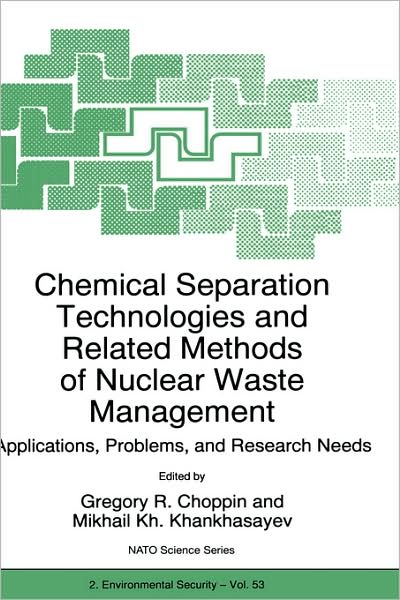
Conte aos seus amigos sobre este item:
Chemical Separation Technologies and Related Methods of Nuclear Waste Management: Applications, Problems, and Research Needs - Nato Science Partnership Subseries: 2 1999 edition
Gregory R Choppin
Chemical Separation Technologies and Related Methods of Nuclear Waste Management: Applications, Problems, and Research Needs - Nato Science Partnership Subseries: 2 1999 edition
Gregory R Choppin
Proceedings of the NATO Advanced Study Institute, Dubna, Russia, May 18-28, 1998
Marc Notes: Proceedings of the NATO Advanced Study Institute on Chemical Separation Technologies and Related Methods: Applications, Problems, and Research Needs, Dubna, Russia, May 18-28, 1998--T.p. verso.; Includes bibliographical references and index. Table of Contents: Preface. Opening session; V. G. Kadyshevsky, et al. I: Nuclear Separation Methods and Technologies: 1944-1998. Overview of Chemical Separation Methods and Technologies; G. R. Choppin. Review of Historical Development and Application of Separation Technologies in Russia; V. N. Romanovsky. Reprocessing of Nuclear Fuel: Overview/Critique of the Worldwide Experience and Engineering/Technology Challenges for Separations; R. G. Wymer. II: Nuclear Separation Methods and Technologies: 1999-?. Technology Needs for Actinide and Technetium Separations Based on Solvent Extraction, Ion Exchange and Other Processes; G. J. Jarvinen. Review of Non-Aqueous Nuclear Fuel Reprocessing and Separation Methods. (View on World Experience from Dimitrovgrad); A. V. Bychkov, O. V. Skiba. Review of Possible Technologies for Actinide Separation Using Other Extractants than TBP; C. Musikas. Studies of the Chemistry of Transactinides by Fast Separation Techniques; I. Zvara. III: Technology Needs for Nuclear Waste Processing. New Extraction Technologies for Management of Radioactive Wastes; V. V. Babain, A. Y. Shadrin. Application of New Inorganic-Organic Composite Absorbers with Polyacrylonitrile Binding Matrix for Separation of Radionuclides from Liquid Radioactive Wastes; J. John, et al. R&D Needs of Chemical Separation Technologies for Nuclear Wastes from the Perspective of Federal Governmental Programs of Russia; M. Khankhasayev, A. V. Komarov. Nuclear Waste Management: A Bioremediation Approach; H. Eccles. IV: Nuclear Wastes and Environment. Up-to-date Radioecological Situation around the Mayak' Nuclear Facility; B. F. Myasoedov, E. G. Drozhko. The Environmental Impacts of Uranium Mining and Milling and the Methods of theirReduction; J. Benes. Role of Humics in Actinide Behavior in Ecosystems; G. R. Choppin. V: Risk Assessment and Safety Issues. Risk Assessment for Chemicals & Radionuclides: Some Characteristics, Similarities and Differences; C. M. Teaf. The View from Russia of the Soviet-Designed Reactor Safety Program of the U. S. Department of Energy; D. W. Wester. Glossary. List of Abbreviations. Index."Publisher Marketing: Separation technologies are of crucial importance to the goal of significantly reducing the volume of high-level nuclear waste, thereby reducing the long-term health risks to mankind. International co-operation, including the sharing of concepts and methods, as well as technology transfer, is essential in accelerating research and development in the field.
| Mídia | Livros Hardcover Book (Livro com lombada e capa dura) |
| Lançado | 28 de fevereiro de 1999 |
| ISBN13 | 9780792356387 |
| Editoras | Springer |
| Páginas | 301 |
| Dimensões | 155 × 235 × 19 mm · 625 g |
| Idioma | English |
| Editor | Choppin, Gregory R. |
| Editor | Khankhasayev, Mikhail Kh. |
Mais por Gregory R Choppin
Ver tudo de Gregory R Choppin ( por exemplo Paperback Book e Hardcover Book )



![Cover for Gregory R Choppin · Separations of f Elements (Paperback Book) [Softcover reprint of the original 1st ed. 1995 edition] (2013)](https://imusic.b-cdn.net/images/item/original/088/9781489914088.jpg?gregory-r-choppin-2013-separations-of-f-elements-paperback-book&class=scaled&v=1409938138)